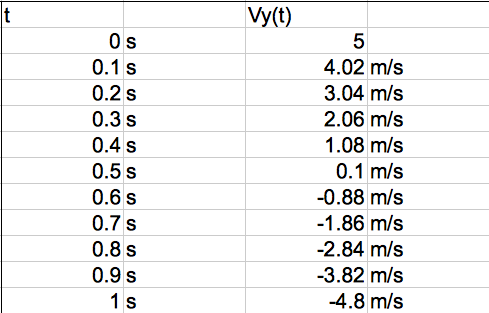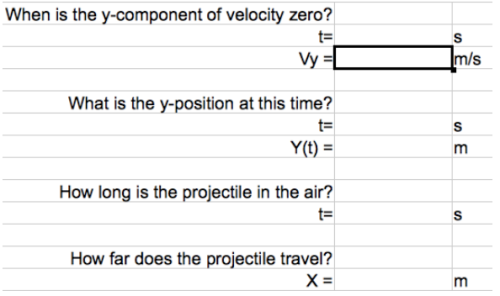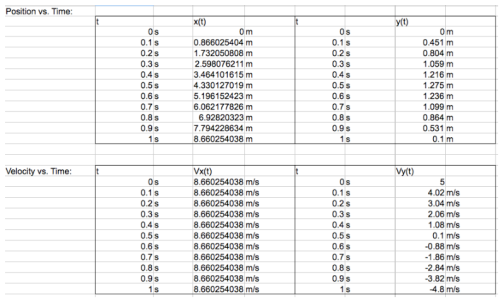I’ve been really excited about how this progression is going with my physics class – today the information really started to click, and I think they are seeing the power of letting the computer do the work.
Here’s what we did last time:
In a fit of rage, Mr. Weinberg throws a Physics textbook while standing in the sand box outside the classroom. By coincidence, the book enters the classroom window exactly when it reaches its maximum height and starts to fall back down.
- Is it appropriate to neglect air resistance in analyzing this situation? Justify your answer.
- We want to use this problem to estimate the height of the classroom window above the ground. Identify any measurements you would take in order to solve this problem. (No, you may not measure the height of the classroom window above the ground.)
- Use your spreadsheet to find the height of the window as accurately as you can.
Note: This activity got the students using the spreadsheet they put together last time to figure out the maximum height of the object. They immediately recognized that they needed some combination of dimensions, an angle, and a launch speed of the book.
These tables of values are easy to read, but we want to come up with a more efficient way to get the information we need to solve a problem.
The table below represents a particular projectile. Identify as much about its movement as you can. How high does it go? How far does it go? When does it get there? That’s the kind of thing we’re interested in here.
Note that at this point the students are spending time staring at tables of equations. This is clearly not an efficient way to solve a problem, but it’s one that they understand, even the weakest students. They can estimate the maximum height by looking at the table of y-values, but the tedium of doing so is annoying, and this is what I want. I try to model this table of values with the spreadsheet they put together with them telling me what to do. Every time I change a value for initial speed or initial height, the location of the maximum changes. It’s never in the same place.
Eventually, someone notices the key to finding the maximum isn’t with the y-position function. It’s with the vertical velocity. When does the y-component equal zero?
This is where the true power of doing this on the spreadsheet comes alive. We look at the table of values, but quickly see that we don’t need a whole table. We go from this:

Clearly this t-value is wrong. Students can adjust the value of the time in that cell until the velocity in the cell below is zero. A weak student will get how to do this – they are involved in the process. The tedium of doing this will prompt the question – is there a better way? Is this when we finally switch to an algebraic approach? No, not yet. This is where we introduce the Goal Seek tool.
The spreadsheet will do the adjustment process for us and find the answer we are looking for. With this answer in hand, we can then move on to posing other questions, and using goal seek to find the values we are looking for.
The process of answering a projectile motion question (how far does it go? how high does it go?) through a spreadsheet then becomes a process of posing the right questions:

This is the type of reasoning we want the students to understand within the projectile motion model. Whether your tool of choice for answering these questions is the graph, equations, or a table of values, posing these questions is the meat and potatoes of this entire unit in my opinion.
The next step is to then introduce algebraic manipulation as an even more general way to answer these questions, including in cases where we don’t have numbers, but are seeking general expressions.
Today I had a student answer the following questions using the goal seek method with the numerical models I’ve described above:
A ball is thrown horizontally from a window at 5 m/s. It lands on the ground 2.5 seconds later. How far does the ball travel before hitting the ground? How high is the window?
He solved it before anyone else. This is a student that has struggled to do any sort of algebraic manipulation all year. There’s something to this, folks. This is the opening to the fourth class of this unit, and we are now solving the same level questions as the non-AP students did a year ago with an algebraic approach and roughly the same amount of instruction time. Some things to keep in mind:
- My students are consistently using units in all of their answers. It is always like pulling teeth trying to get them to include units – not so much at the moment.
- They are spending their time figuring out the right questions to ask, not which equation to ‘plug’ into to get an answer.
- They immediately see what information is missing in their model at the beginning of a problem. They read the questions carefully to see what they need.
- The table of values gives them an estimate they can use for the problem. They have an idea of what the number should be from the table, and then goal seek improves the accuracy of the number.
- At the end of the problem, students have all of the initial information filled out to describe all of the parts of the problem. They can check that the horizontal range, maximum height, and other waypoints of the path match the given constraints of the problem. This step of checking the answer is a built-in feature to the process of matching a model – not an extra step that I have to demand at the end. If it doesn’t match all of the given constraints, it is obvious.
I am looking for push back – is there anything I am missing in this approach? I get that deriving formulas is not going to come easily this way, but I think with a computer algebra system, it’s not far away.




